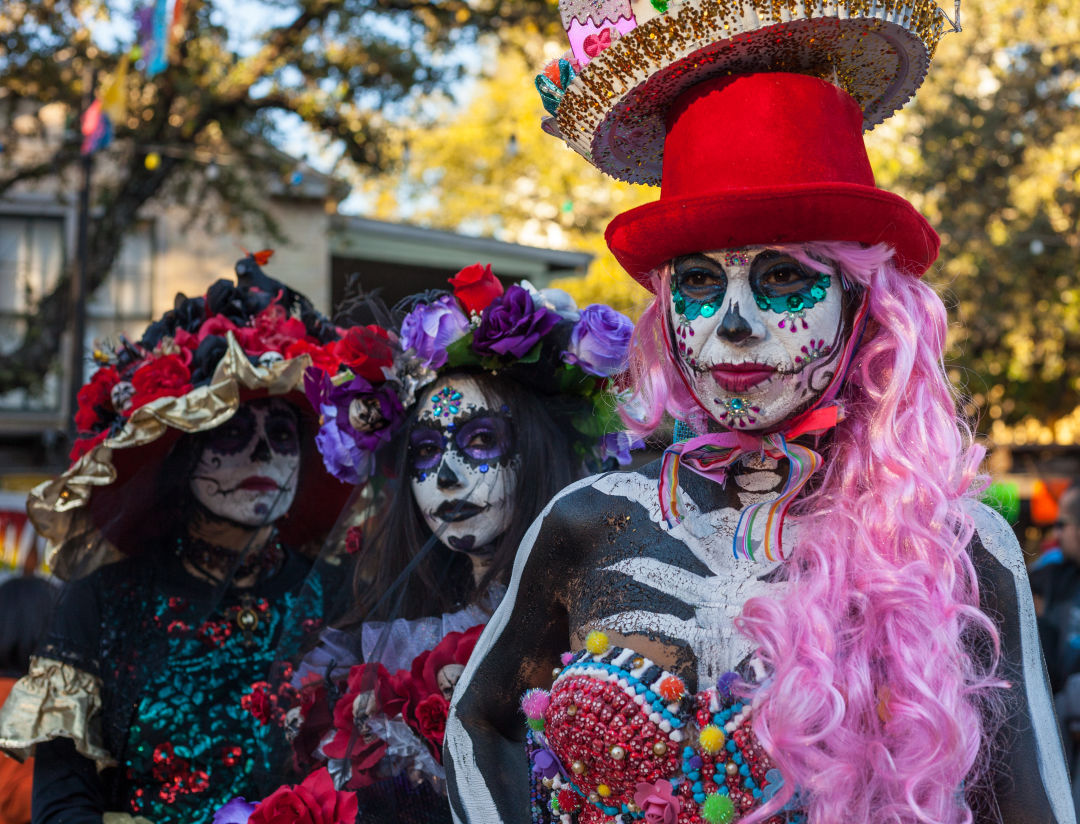All Saints Day and the Day of the Dead (Dia de Muertos) happen around the same time every year. Sometimes, those who celebrate these holidays talk about “the Days of the Dead.”
This is because they actually span November 1st and November 2nd. While the Days of the Deadfall on the Catholic holidays of All Saints Day and All Souls Day, they have several key differences. All Saints Day and All Souls Day originated within the Catholic church and are celebrated by Catholics and Anglicans. The Days of the Dead have their roots in pre-Christian indigenous culture. They do not have anything to do with honoring saints and martyrs specifically but are for remembering loved ones who have passed away.
Day of the Dead, or Dia de Muertos, is a three-day-long Mexican holiday remembering those who have passed. People dress up and participate in gatherings and processions, including bringing food and offerings to cemeteries, to celebrate the lives of those they have lost.
It is so inextricably linked to the fabric of Mexican society that UNESCO has declared the holiday an Intangible Cultural Heritage of Humanity.
The Dia de Muertos celebrations traditionally take place each year between October 31 and November 2 and, while the dates coincide with our observance of Halloween, the two holidays differ greatly in spirit and tone.
If you’ve never attended a Dia de Muertos event before, you still might be familiar with some of the decorations and offerings made for the yearly event, like colorful sugar skulls.
Dia de Muertos tradition is strongest in Southern Mexico
Although festivities take place in towns and cities all across Mexico, each region has its own way of reconnecting with departed friends and relatives on this special occasion. The root Mesoamerican tradition, dating back thousands of years before Spanish rule, originated in the area now known as Southern Mexico, including the Yucatan peninsula. Mixquic, southeast of Mexico City, is known as ‘City of the Dead’ for its procession that calls at shrines to the deceased. A popular location is Oaxaca, where there are graveyard tours and a ‘best altar’ competition. If you do find yourself in the north, head to Guanajuato, where salesmen dole out mummy candies outside the gruesome Museo de las Momias (Museum of Mummies). On Janitzio Island, Lake Pátzcuaro, the arrival of flower-covered, candle-lit canoes begins a nightlong vigil-come-party.
In a belief system inherited from the Aztecs, Mexicans believe their dead are lurking in Mictlan, a kind of spiritual waiting room, and they can return to their homes at this time of year. Families thus begin preparations to help the spirits find their way home and to make them welcome, starting with an arch made of bright yellow marigolds – a symbolic doorway from the underworld. An altar is erected and piled high with offerings to the invisible visitors: flowers, ribbons, coloured candles, tamales (steam-cooked corn-meal dough), fruit and corn. Two important additions are a container of water because the spirits arrive thirsty after their journey, and pan de muertos (bread of the dead). The loaf is made with egg yolks, fruits and tequila or mezcal, and is adorned with, or shaped as, a symbol of death.
First day: Día de Angelitos (October 31st)
The first day, Día de Angelitos (Day of the Little Angels), is dedicated to dead children, and the toys they once loved are placed on the altar.
The rituals are particularly important if the household has suffered a bereavement in the previous year. Women will spend all day cooking the favourite food of the dead relative for the customary feast, in which friends and family gather to toast the ghostly visitors.

The event climaxes with a visit to the cemetery. There might be a funfair en route, with neon-lit rides and stands selling crucifix waffles and cooked cactus snacks. Families will devote a day to cleaning the graves, decorating them with candles and flores del muerto (flowers of the dead), having picnics and dancing to mariachi bands. By now, the streets are full of papier-mâché skeletons, which are life-size but could never pass for the real thing in their dresses, jewellery, flowery boas and hats. A cigarette dangles jauntily from a white hand, a hoop earring hangs against a bare jawbone.
The second day is Dia de los innocents (November 1st) and the third day is the Day of the Dead (November 2nd)
Again, such apparitions can be traced back to Aztec lore. The death god, Mictlantecutli, is often depicted with a skull-like face in pre-Hispanic artefacts. The skeletal street urchins became a major fixture in the late 19th century, when the great engraver José Guadalupe Posada used the occasion to satirise society and explore the theme of death as the ultimate leveller. In his famous calaveras, skeletal figures cheerfully engage in everyday life, working, dancing, courting, drinking and riding horses into battle. One of his most enduring characters is La Calavera Catrina, a female skeleton in an elaborate low-cut dress and flamboyant flower-covered hat, suggestively revealing a bony leg and an ample bust that is all ribs and no cleavage.
The event is, like many aspects of post-colonial Mexico, a melange of influences. Its origins stretch back to the Aztec month of Miccailhuitontli, which was dedicated to deathly Mictlantecutli’s equally scary wife, Mictecacihuat. It originally fell around August, but the Christian conquistadors, hoping to assimilate the heathen holiday through their favoured tactic of cultural mestizaje (mixing), moved it to the day after All Saint’s Day.
Visiting Mexico?




